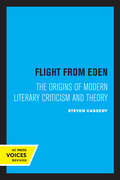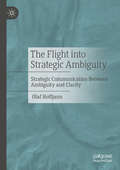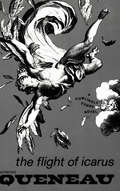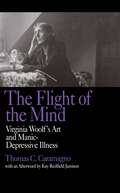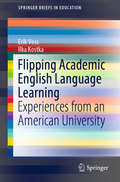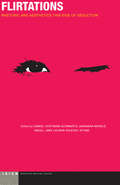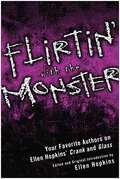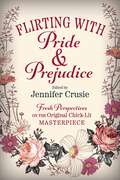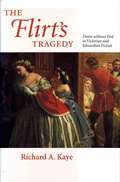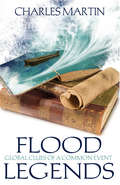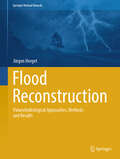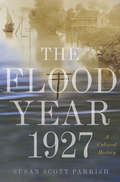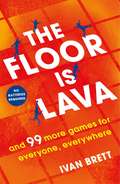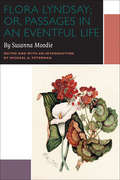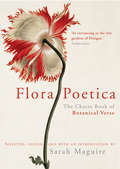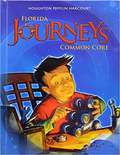- Table View
- List View
The Flies (SparkNotes Literature Guide Series)
by SparkNotesThe Flies (SparkNotes Literature Guide) by Jean-Paul Sartre Making the reading experience fun! Created by Harvard students for students everywhere, SparkNotes is a new breed of study guide: smarter, better, faster.Geared to what today's students need to know, SparkNotes provides:chapter-by-chapter analysis explanations of key themes, motifs, and symbols a review quiz and essay topics Lively and accessible, these guides are perfect for late-night studying and writing papers.
Flight from Eden: The Origins of Modern Literary Criticism and Theory
by Steven CassedySteven Cassedy takes aim at two of the most enduring myths of modern criticism: that it is secular, and that it is new and autonomous. He argues that though modern criticism is often forbiddingly scientific and technical, the modern critic remains something of a mystic. Every school of modern criticism—from structuralism to postmodern criticism—rests on a faith in an "Eden," an irreducible essence, a myth, like the common myth that there is an intrinsic distinction between "poetic" language and "ordinary" language. The modern critic attempts to abandon all mystical faith; this is the "flight from Eden." But it is always in vain. It is traditionally assumed that modern literary criticism and theory came from France, and relatively recently. In fact, according to Cassedy, the entire modern critical consciousness was already formed by the early twentieth century in the minds of writers who were primarily neither professional critics nor philosophers, but poets. Some were French (Mallarmé, and Valéry); others were not (Rilke, Bely, and the Russian avant-garde poet Velimir Khlebnikov). In them we find the same Edenic faith, the same effort to abandon it, and the same failure of that effort. This title is part of UC Press's Voices Revived program, which commemorates University of California Press’s mission to seek out and cultivate the brightest minds and give them voice, reach, and impact. Drawing on a backlist dating to 1893, Voices Revived makes high-quality, peer-reviewed scholarship accessible once again using print-on-demand technology. This title was originally published in 1990.
The Flight into Strategic Ambiguity: Strategic Communication Between Ambiguity and Clarity
by Olaf HoffjannThis book analyses how and why advertising, PR, and corporate and political communication make use of strategic ambiguity. This special quality of vagueness allows companies to talk about the relevance of ESG or governments to promise stability and prosperity without fully committing themselves, disappointing no one and securing every freedom. This book describes in detail the diverse practices of ambiguous strategic communication – and its opposite, strategic clarity – with many examples. For academics, it offers a detailed framework for describing and researching strategic ambiguity. For PR practitioners, it provides a toolbox for the use of strategic ambiguity. Lastly, it provides journalists with a means of recognizing and criticizing questionable strategic ambiguity. This book is a translation of the original German edition “Die Flucht in die Ambiguität”. The translation was done with the help of an artificial intelligence machine translation tool. A subsequent human revision was done primarily in terms of content, so that the book will read stylistically differently from a conventional translation.
The Flight of Icarus: Novel
by Raymond QueneauThe Flight of Icarus (Le Vol d'lcare) is his only novel written in the form of a play: seventy-four short scenes, complete with stage directions. Called by some the French Borges, by others the creator of le nouveau roman a generation ahead of its time, Raymond Queneau's work in fiction continues to defy strict categorization. The Flight of Icarus (Le Vol d'lcare) is his only novel written in the form of a play: seventy-four short scenes, complete with stage directions. Consciously parodying Pirandello and Robbe-Grillet, it begins with a novelist's discovery that his principal character, Icarus by name, has vanished. This, in turn, sets off a rash of other such disappearances. Before long, a number of desperate authors are found in search of their fugitive characters, who wander through the Paris of the 1890s, occasionally meeting one another, and even straying into new novels. Icarus himself--perhaps following the destiny his name suggests--develops a passion for horseless carriages, kites, and machines that fly. And throughout the almost vaudevillian turns of the plot, we are aware, as always, of Queneau's evident delight at holding the thin line between farce and philosophy.
The Flight of the Mind: Virginia Woolf's Art and Manic-Depressive Illness
by Thomas C. CaramagnoIn this major new book on Virginia Woolf, Caramagno contends psychobiography has much to gain from a closer engagement with science. Literary studies of Woolf's life have been written almost exclusively from a psychoanalytic perspective. They portray Woolf as a victim of the Freudian "family romance," reducing her art to a neurotic evasion of a traumatic childhood.But current knowledge about manic-depressive illness—its genetic transmission, its biochemistry, and its effect on brain function—reveals a new relationship between Woolf's art and her illness. Caramagno demonstrates how Woolf used her illness intelligently and creatively in her theories of fiction, of mental functioning, and of self structure. Her novels dramatize her struggle to imagine and master psychic fragmentation. They helped her restore form and value to her own sense of self and lead her readers to an enriched appreciation of the complexity of human consciousness.
Flipping Academic English Language Learning: Experiences from an American University (SpringerBriefs in Education)
by Erik Voss Ilka KostkaThis book draws on theory, research, and practice-oriented literature to offer an introduction to flipped learning and offer busy instructors advice on how to flip their academic English language courses. The chapters balance theoretical foundations, practical applications, and useful resources for developing materials. The first half of this book defines flipped learning and academic English, describes how it supports English language learning, and explains the role of technology, as well as issues with accountability and feedback. The second half of the book then makes connections between the theoretical issues presented in the first three chapters and the practical applications in the following chapters, which provide lesson descriptions and assessment ideas for language learning contexts with or without access to technology. The book concludes with a list of tools and technologies for developing materials and activities, as well as additional resources for professional development and further exploration of flipped English language learning.
Flirtations: Rhetoric and Aesthetics This Side of Seduction (Idiom: Inventing Writing Theory)
by Barbara Natalie Nagel Lauren Shizuko StoneWhat is flirtation, and how does it differ from seduction?In historical terms, the particular question of flirtation has tended to be obscured by that of seduction, which has understandably been a major preoccupation for twentieth-century thought and critical theory. Both the discourse and the critique of seduction are unified by their shared obsession with a very determinate end: power. In contrast, flirtation is the game in which no one seems to gain the upper hand and no one seems to surrender. The counter-concept of flirtation has thus stood quietly to the side, never quite achieving the same prominence as that of seduction. It is this elusive (and largely ignored) territory of playing for play’s sake that is the subject of this anthology.The essays in this volume address the under-theorized terrain of flirtation not as a subgenre of seduction but rather as a phenomenon in its own right. Drawing on the interdisciplinary history of scholarship on flirtation even as it re-approaches the question from a distinctly aesthetic and literary-theoretical point of view, the contributors to Flirtations thus give an account of the practice of flirtation and of the figure of the flirt, taking up the act’s relationship to issues of mimesis, poetic ambiguity, and aesthetic pleasure. The art of this poetic playfulness—often read or misread as flirtation’s “empty gesture”—becomes suddenly legible as the wielding of a particular and subtle form of nonteleological power.
Flirtin' With the Monster: Your Favorite Authors on Ellen Hopkins' Crank and Glass
by Ellen HopkinsWhere is the line between truth and fiction? Why do love and addiction so often go hand in hand? What does the real "Kristina" think about the way her story is told in Crank and Glass? Crank and Glass have always been more than just stories. Join their author Ellen Hopkins and a host of other writers as they delve deep into Kristina's story, from the straight truth on the physical effects of methamphetamine addiction to the psychological consequences of keeping secrets (and how Hopkins' books have encouraged so many teens to reveal theirs). With an essay by Ellen's real-life daughter (the basis for the character of "Kristina") that tells her version of the events that inspired the books—along with perspectives from "Scott," "Jake," and 10-year-old "Hunter," the baby from Crank—Flirtin' with the Monster is a compelling journey through the complexities of Hopkins' beloved bestselling works.
Flirting With Pride And Prejudice: Fresh Perspectives On The Original Chick Lit Masterpiece
by Jennifer Crusie and Glenn YeffethOne of fiction's most well-loved novels, this 19th-century classic continues to capture the hearts of contemporary readers with its notions of marriage, dating, and romance. Leading authors in the area of women's literature and romance contribute to this fresh collection of essays on everything from Lydia's scandalous marriage to George Wickham to the female-dominated Bennett household and the emphasis placed on courtship and marriage. Contributors include Jo Beverly, Alesia Holliday, Mercedes Lackey, Joyce Millman, and Jill Winters. This compilation is an excellent companion for both those new to Jane Austen and well-versed Austen-philes.
The Flirt's Tragedy: Desire without End in Victorian and Edwardian Fiction
by Richard A. KayeIn the flirtation plots of novels by Jane Austen, Charlotte Brontë, and W. M. Thackeray, heroines learn sociability through competition with naughty coquette-doubles. In the writing of George Eliot and Thomas Hardy, flirting harbors potentially tragic consequences, a perilous game then adapted by male flirts in the novels of Oscar Wilde and Henry James. In revising Gustave Flaubert's Sentimental Education in The Age of Innocence, Edith Wharton critiques the nineteenth-century European novel as morbidly obsessed with deferred desires. Finally, in works by D. H. Lawrence and E. M. Forster, flirtation comes to reshape the modernist representation of homoerotic relations.In The Flirt's Tragedy: Desire without End in Victorian and Edwardian Fiction, Richard Kaye makes a case for flirtation as a unique, neglected species of eros that finds its deepest, most elaborately sustained fulfillment in the nineteenth-century and early twentieth-century novel. The author examines flirtation in major British, French, and American texts to demonstrate how the changing aesthetic of such fiction fastened on flirtatious desire as a paramount subject for distinctly novelistic inquiry. The novel, he argues, accentuated questions of ambiguity and ambivalence on which an erotics of deliberate imprecision thrived. But the impact of flirtation was not only formal. Kaye views coquetry as an arena of freedom built on a dialectic of simultaneous consent and refusal, as well as an expression of "managed desire," a risky display of female power, and a cagey avenue for the expression of dissident sexualities. Through coquetry, novelists offered their response to important scientific and social changes and to the rise of the metropolis as a realm of increasingly transient amorous relations.Challenging current trends in gender, post-gender, and queer-theory criticism, and considering texts as diverse as Darwin's The Descent of Man and Gilbert and Sullivan's The Mikado, Kaye insists that critical appraisals of Victorian and Edwardian fiction must move beyond existing paradigms defining considerations of flirtation in the novel. The Flirt's Tragedy offers a lively, revisionary, often startling assessment of nineteenth-century fiction that will alter our understanding of the history of the novel.
A Floating Chinaman: Fantasy and Failure across the Pacific
by Hua HsuWho gets to speak for China? During the interwar years, when American condescension toward China yielded to fascination with all things Chinese, a circle of writers sparked an unprecedented conversation over U.S.-Chinese relations. Hua Hsu tells how they became ensnared in bitter rivalries over who could claim the title of leading China expert.
Flood Legends
by Charles MartinThe story of the Deluge - or the Global Flood of Noah - permeates nearly every culture in the world in some way, shape, or form. While details vary between the different cultures, the same basic elements, occur in all versions. In "Flood Legends" you will discover: Detailed analysis of myth, legend, and historical details that are clues for a common, global event Unique research from a comparative study supporting the biblical history Despite the striking similarities of these accounts, some mythologists have looked at the minor differences in the stories and declared: "This never happened!" There is another alternative - to accept that the different versions all refer to the same event - passed on from generation to generation, through various developing cultures. Through these legends, this epic event has remained woven into the tapestry of cultural history - sharing not just the story of survival, but the power of obedience, and the fulfillment of God's enduring promise.
Flood Reconstruction: Palaeohydrological Approaches, Methods and Results (Springer Natural Hazards)
by Jürgen HergetFloods are among the most common and consequential natural disasters on Earth, occurring in all natural areas at all times. Yet, they often surprise us with their unexpected magnitude and the damage they cause. Terms like century and millennium floods quickly become widespread, but what do we really know about the floods of the past? How can we truly classify events like the Mississippi flood of 1993, the Elbe flood of 2002, or the Pakistan flood of 2010? Have such floods occurred before, or are they unprecedented, perhaps even consequences of ongoing climate change? To answer these questions, we must look into the past. However, river level records are often limited in duration, rarely extending back more than a hundred years, and many regions lack any measured values at all. Nonetheless, floods have left their marks. These marks may exist in the form of historical records and descriptions, which vary in extent across different cultural contexts. In addition to historical records, natural indicators like deposited sediments or erosion traces provide valuable information about past flood levels. This is particularly important for prehistoric periods and for regions without dense settlements and related gauges. These investigations lead to further questions about maximum flood levels and the earliest recorded observations. This book addresses these questions by exploring the reconstruction of floods from both historical and prehistoric times. It explains and discusses methods and results for beginners with diverse backgrounds in disciplines such as earth sciences, hydrology, history, and engineering. Extensive and carefully selected reference lists offer access to additional information.
The Flood Year 1927: A Cultural History
by Susan Scott ParrishThe Great Mississippi Flood of 1927, which covered nearly thirty thousand square miles across seven states, was the most destructive river flood in U.S. history. Due to the speed of new media and the slow progress of the flood, this was the first environmental disaster to be experienced on a mass scale. As it moved from north to south down an environmentally and technologically altered valley, inundating plantations and displacing more than half a million people, the flood provoked an intense and lasting cultural response. The Flood Year 1927 draws from newspapers, radio broadcasts, political cartoons, vaudeville, blues songs, poetry, and fiction to show how this event took on public meanings.Americans at first seemed united in what Herbert Hoover called a “great relief machine,” but deep rifts soon arose. Southerners, pointing to faulty federal levee design, decried the attack of Yankee water. The condition of African American evacuees in “concentration camps” prompted pundits like W.E.B. Du Bois and Ida B. Wells to warn of the return of slavery to Dixie. And environmentalists like Gifford Pinchot called the flood “the most colossal blunder in civilized history.” Susan Scott Parrish examines how these and other key figures—from entertainers Will Rogers, Miller & Lyles, and Bessie Smith to authors Sterling Brown, William Faulkner, and Richard Wright—shaped public awareness and collective memory of the event.The crises of this period that usually dominate historical accounts are war and financial collapse, but The Flood Year 1927 enables us to assess how mediated environmental disasters became central to modern consciousness.
The Floor is Lava: and 99 more screen-free games for all the family to play
by Ivan Brett'A brilliant book of 100 games you can play anywhere in your house or garden.' The Sun Playing games can be so enjoyable but don't you often find yourself playing the same old games time and time again? Well, why not let Ivan Brett inspire you with over 99 games to entertain any gathering of friends or family? Inside The Floor is Lava you'll find 100 games to satisfy any busy family and most require no equipment other than pencil and paper. There's everything from fiendish brain teasers and number puzzles to witty wordplays and physical challenges. You'll find something for everyone to enjoy and avoid the whole family resorting to screen-time! In short, this is a how-to for turning time together into quality time together. It's time to put down your screens and pick up the fun! You'll find games for every occasion: * occupy the kids on rainy days* have after-dinner fun around the table * liven up a party * cool off in the summer holidays* beat boredom in the car So what are you waiting for? Jump up and get started - the floor is lava Ivan's next book Bored? Games! 101 games to make every day more playful is out in June. You can PRE-ORDER NOW!
The Floor is Lava: and 99 more screen-free games for all the family to play
by Ivan Brett'A brilliant book of 100 games you can play anywhere in your house or garden.' The Sun Playing games can be so enjoyable but don't you often find yourself playing the same old games time and time again? Well, why not let Ivan Brett inspire you with over 99 games to entertain any gathering of friends or family? Inside The Floor is Lava you'll find 100 games to satisfy any busy family and most require no equipment other than pencil and paper. There's everything from fiendish brain teasers and number puzzles to witty wordplays and physical challenges. You'll find something for everyone to enjoy and avoid the whole family resorting to screen-time! In short, this is a how-to for turning time together into quality time together. It's time to put down your screens and pick up the fun! You'll find games for every occasion: * occupy the kids on rainy days* have after-dinner fun around the table * liven up a party * cool off in the summer holidays* beat boredom in the car So what are you waiting for? Jump up and get started - the floor is lava Ivan's next book Bored? Games! 101 games to make every day more playful is out in June. You can PRE-ORDER NOW!
Flora Lyndsay; or, Passages in an Eventful Life: A Novel by Susanna Moodie (Canadian Literature Collection)
by Susanna MoodieFlora Lyndsay is Susanna Moodie’s prequel to Roughing it in the Bush and Life in the Clearings. Though Moodie fictionalizes herself in the context of this novel, Flora Lyndsay remains a close personalized record of her family’s experiences in planning their emigration and crossing the Atlantic. Despite the limited critical attention it receives, Flora Lyndsay reveals Moodie’s style, her sense of form, and her distinctive approach to writing female autobiography. This edition, complete with a wide corpus of endnotes, an extensive list of emendations, and a critical introduction, helps address this oversight and gives a closer look at the iconic phenomenon that is Susanna Moodie.
Flora Poetica: The Chatto Book of Botanical Verse
by Sarah MaguireThis beautiful anthology brings together over 250 poems about flowers, plants and trees from eight centuries of writing in English, creating a rich bouquet of intriguing juxtapositions. Fourteenth-century lyrics sit next to poems of the twenty-first century; celebrations of plants native to the English soil share the volume with more exotic plant poetry. There are thirty poems about roses, by poets as diverse as Shakespeare, Dorothy Parker and the South African, Seitlhamo Motsapi; but there are also sections devoted to more unusual plants such as the mandrake, the starapple and the tamarind. An ex-gardener, the celebrated poet Sarah Maguire brings her extensive horticultural knowledge to bear on all the poems, arranging them into botanical families, identifying the plants being written about and writing a fascinating introduction. Whether you are a poetry lover, a gardener, a botanist, or simply the purchaser of the occasional bunch of flowers, this unique anthology allows you to luxuriate amidst the world's flora.
Florence Macarthy: by Sydney Owenson (Chawton House Library: Women's Novels)
by Jenny McAuleyThis is the first modern scholarly edition of Florence Macarthy: An Irish Tale (1818). Owenson's seventh novel, it is the most sophisticated of her four 'national tales'. Owenson combined conventional romance plotlines with the political and social problems in Ireland, following the passing of the Act of Union in 1800.
Florida Collections (Grade #11)
by Holt McdougalA literature book that helps build juvenille reading skills
Florida Holt Elements of Literature, Third Course
by Kylene Beers Carol Jago Deborah ApplemanNIMAC-sourced textbook
Florida SRA Imagine It! Level 2, Book 1, Themes: Kindness, Let's Explore, Around the Town
by Carl Bereiter Andy Biemiller Joe Campione Iva Carruthers Doug Fuchs Lynn Fuchs Steve Graham Karen Harris Jan Hirshberg Anne Mckeough Peter Pannell Michael Pressley Marsha Roit Marlene Scardamalia Marcy Stein Gerald H. Treadway Jr.NIMAC-sourced textbook
Florida SRA Imagine It! Level 2, Book 2, Themes: Look Again, Courage, America's People
by Sra Mcgraw-HillNIMAC-sourced textbook

